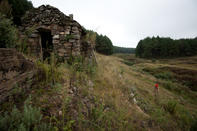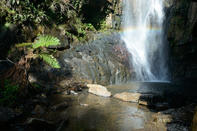Gold-rush Days in Kaapsehoop
Situated on the Edge of the Escarpment, Kaapsehoop appeared virtually overnight following the discovery of alluvial gold on the farm Berlyn (Berlin) in 1880.

Originally named Duiwels Kantoor (Devil's Office), it was renamed Kaapsehoop to reflect expectations of rich finds. By August 1882 there were 250 diggers at Kaapsehoop, and by early 1884 their numbers had swelled to some 4 000.
In its heyday, the village had two hotels, several bars, 15 shops, a school, post office and an assortment of corrugated-iron cottages and clay-brick houses. Most of the diggers abandoned the settlement when the Pioneer Reef was discovered near Barberton. After the discovery of Barber's Reef and the Sheba Reef in 1885, only a handful of diggers remained behind.
Creeks and Streams in Kaapsehoop

Reminders of this colourful era include the remains of the old government building (1885) and the magistrate's office at the town square (known as Kommisarisplein), corrugated-iron miners' cottages, the old pear orchard with its unbelievably huge trees and the cemetery. The descriptive names of the area's many creeks and streams, such as Poverty Creek, Starvation Creek, Fool's Rush and Battery Creek, with its delightful waterfall, evoke memories of gold-rush days for tourists on South African holidays.
The montane grassveld plain to the southeast of the village is the most important habitat of the endangered blue swallow in South Africa, while small groups of wild horses still roam the area; these are said to be the descendants of abandoned mining ponies and horses used in the South African War.